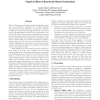305 search results - page 49 / 61 » Improving IEEE 802.11 power saving mechanism |
HPCA
2005
IEEE
14 years 9 months ago
2005
IEEE
The use of large instruction windows coupled with aggressive out-oforder and prefetching capabilities has provided significant improvements in processor performance. In this paper...
IPPS
2007
IEEE
14 years 2 months ago
2007
IEEE
While improving raw performance is of primary interest to most users of high-performance computers, energy consumption also is a critical concern. Some microprocessors allow volta...
MSS
2007
IEEE
14 years 2 months ago
2007
IEEE
The volume of online data content has shown an un precedented growth in recent years. Fueling this growth are new federal regulations which warrant longer data re tention and ...
ISCA
2006
IEEE
14 years 2 months ago
2006
IEEE
Level one cache normally resides on a processor’s critical path, which determines the clock frequency. Directmapped caches exhibit fast access time but poor hit rates compared w...
ICCAD
2010
IEEE
13 years 6 months ago
2010
IEEE
Reducing circuit's peak current plays an important role in circuit reliability in deep sub-micron era. For sequential circuits, it is observed that the peak current has a str...

